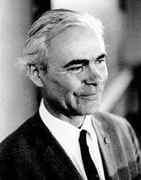Person: Sachs, Horst

Horst Sachs was a German mathematician and an expert in graph theory.
Mathematical Profile (Excerpt):
- When Sachs was fifteen years old he had been made a gunner operating an anti-aircraft gun, then at age sixteen he was, for a short time, in the Reich Labour Service.
- Sachs' military training began in the autumn of 1944 in the infantry.
- Sachs was one of the defenders and, when the Germans were defeated, after inflicting heavy casualties on the British, he was taken prisoner.
- Sachs was actually transferred in June 1946.
- Sachs was one of a great many young men who had served in the military at a time when they should have been attending high school, so he received his Abitur at the same time as a great many others who wanted to continue their interrupted studies or wanted to apply to begin a university course.
- Sachs was helped by the fact that his grades had been excellent but, nevertheless, he had to give up the idea of studying languages because of the numbers of applicants, and chose instead to apply to the University of Halle to study mathematics.
- Sachs' favourite professor was Herbert Grötzsch (1902-1993), an expert on graph theory who had been a student of Paul Koebe.
- Because of his excellent performance, Sachs was awarded a scholarship.
- In 1949, while Sachs was a student at the University of Halle, the German Democratic Republic (GDR) was established.
- In 1953 Sachs was awarded his Diploma in mathematics from the Martin Luther University of Halle.
- After graduating, Sachs became an Aspirant.
- The only duties were giving two hours of lectures a week, otherwise Sachs could concentrate on his research.
- Sachs was awarded his doctorate in 1958 for his thesis Beiträge zur Theorie gewisser isoperimetrischer Probleme Ⓣ(Contributions to the theory of certain isoperimetric problems).
- After the award of his doctorate, Sachs worked towards submitting an habilitation thesis.
- In 1959 Sachs spent eight weeks in Budapest on a research visit.
- He was a particularly strong influence on Sachs.
- Sachs habilitated at the Martin Luther University of Halle in the spring of 1963 and, immediately, was offered a professorship at the Technical University of Ilmenau.
- Apart from pure mathematics, Sachs successfully cooperated with chemists (where he worked out interesting connections to graph theory) and physicists, and was interested in the history of mathematics.
- These are not Sachs' only books.
- Three years later, in 1990, Sachs published Isotrope Geometrie des Raumes Ⓣ(Isotropic geometry of space).
- Professor Horst Sachs (70) from Ilmenau, who settled down in the GDR, looks back with gratitude, even nostalgia on this state, and who claims that even today socialism cannot be dismissed that easily.
- The septuagenarian Sachs, who retired in 1992, views the Change as an annexation by the Federal Republic and as the victory of money.
- Sachs was a fellow of the Institute of Combinatorics and its Applications and was awarded its Euler Medal in 2000.
- Whereas most of us would enjoy a beautiful proof but consider a problem to be solved if there is just any correct proof, Sachs took a step further and considered a problem to be finally settled only if it comes with a beautiful solution, in terms of transparency and precision (and other, more subjective measures).
Born 27 March 1927, Magdeburg, Germany. Died 25 April 2016, Ilmenau, Germany.
View full biography at MacTutor
Tags relevant for this person:
Origin Germany
Thank you to the contributors under CC BY-SA 4.0! 

- Github:
-

- non-Github:
- @J-J-O'Connor
- @E-F-Robertson
References
Adapted from other CC BY-SA 4.0 Sources:
- O’Connor, John J; Robertson, Edmund F: MacTutor History of Mathematics Archive
